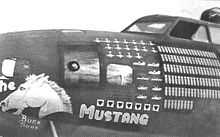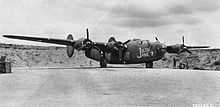403d Bombardment Squadron
| 403d Bombardment Squadron | |
|---|---|
|
Emblem of the 403d Bombardment Squadron | |
| Active | 1940-1961 |
| Country | United States |
| Branch | United States Air Force |
| Role | Bombardment |
| Part of | Strategic Air Command |


The 403d Bombardment Squadron is an inactive United States Air Force unit. It was last assigned to the 43rd Bombardment Wing, based at Carswell AFB, Texas. It was inactivated on 1 January 1961.
History
Established in 1940 and activated in 1941 as a long range reconnaissance squadron, assigned to the GHQ Air Force Northeast Air District. Trained and was equipped with both early model B-17C/D Flying Fortress heavy bombers. along with and B-18 Bolo medium bombers and A-29 Hudsons at Langley Field. Primarily flew training missions over the Mid-Atlantic States. After the Pearl Harbor Attack, was deployed to New England and began flying antisubmarine missions from Bangor Airport over the Newfoundland Straits and performing aerial convoy patrols over the North Atlantic shipping lanes.
Deployed to Australia in February 1942, being assigned to the new Fifth Air Force being formed after the withdraw from the Philippines of remaining heavy bombers. The squadron reached Australia in March 1942 and was redesignated as a heavy bombardment squadron in April. Did not enter combat until September, when it finally had a reasonable complement of aircraft. From then until November 1944 the squadron operated in support of the campaign in Papua New Guinea, first from Australia, then from New Guinea and Owi Island, concentrated in particular in attacks on shipping. The unit experimented with low level skip bombing, using this tactic at the Battle of the Bismarck Sea, 2–4 March 1943 with some success.
Between May and September 1943 the squadron's B-17s were replaced with B-24 Liberators, believed to be more suited to the long ranges of many Pacific missions. In November 1944 the squadron moved to the Philippines, helping the ground campaign on Luzon as well as conducting long range strategic bombing missions against targets in China and Formosa. Finally in July 1945 it moved to Le Shima, from where it flew missions over Japan, still attacking shipping, as well as airfields and railways until the Japanese Capitulation in August. Squadron demobilized on Okinawa, aircraft being sent to the Philippines for reclamation. Inactivated as a paper unit in April 1946.
The squadron was activated in 1958 as a result of Strategic Air Command phasing out the B-47 Stratojet, and additional squadrons were activated as part of the consolation of Stratojet wings, and the replacement of the B-47 by B-52 Stratofortresses. The squadron was inactivated on 1 January 1961 as part of the drawdown of the USAF B-47 force, with the aircraft were sent to AMARC storage at Davis-Monthan.
Lineage
- Constituted 13th Reconnaissance Squadron (Heavy) on 20 November 1940
- Activated on 15 January 1941
- Redesignated 403d Bombardment Squadron (Heavy) on 22 April 1942
- Inactivated on 29 April 1946
- Redesignated 403d Bombardment Squadron (Medium) on 20 August 1958
- Activated on 1 December 1958
- Discontinued on 15 March 1960
- Organized on 15 May 1960
- Discontinued, and inactivated, on 1 January 1961.
Assignments
- 43rd Bombardment Group, 15 January 1941 – 29 April 1946
- Associated with: 1st Photographic Group, 15 Jan 1941-22 Apr 1942 (Training)
- 43rd Bombardment Wing, 1 December 1958
- Department of the Air Force, 15 March 1960
- Strategic Air Command, 12 April 1960
- 43rd Bombardment Wing, 15 May 1960 – 1 January 1961
Stations
|
|
Aircraft
- Included B-17 and B-18, 1941
- B-18 and A-29 for antisubmarine operations, 1941–1942
- B-17 Flying Fortress, 1942–1943
- B-24 Liberator,1942–1945
- B-47 Stratojet, 1958–1960
Operational history
Antisubmarine, December 1941— January 1942; combat in Southwest and Western Pacific, October 1942-12 August 1945; not fully manned or equipped, 23 November 1945 – 29 April 1946. Strategic Air Command bombardment squadron, 1947-1960.
See also
References
![]() This article incorporates public domain material from websites or documents of the Air Force Historical Research Agency.
This article incorporates public domain material from websites or documents of the Air Force Historical Research Agency.
- Maurer, Maurer, ed. (1982) [1969]. Combat Squadrons of the Air Force, World War II (reprint ed.). Washington, DC: Office of Air Force History. ISBN 0-405-12194-6. LCCN 70605402. OCLC 72556.
External links
| ||||||||||||||||||||||||||||||||||||||||||||||||||||||||||||||||||||||||||


.svg.png)